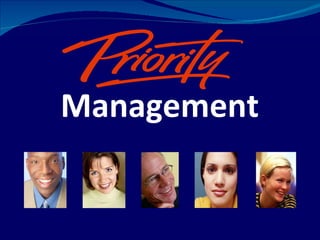PM Pre-Presentation
- 1. Management
- 2. Managing workflow & priorities Working Sm@rt with MS Outlook, Lotus Notes, GroupWise Manager
- 3. Priority Management Process Phase I Priority Manager workshop Phase II Personal Coaching Phase III Refresh & LearningLink
- 4. Phase I Priority Manager workshop
- 5. Workshop: outline Priority productivity process Your electronic tools The digital deluge Managing commitments Managing communications Managing activities Priority Planning TeamTools Eliminate DeskStress Putting MS Outlook to work Email Calendar Contacts Tasks
- 6. Best practice principals Touch it once All in one place Manage expectations Be realistic Write it down Follow up delegated work Prioritise based on objectives Plan ahead Be pro-active Work as a team
- 7. What do you want to achieve? What stops youâĶ?
- 8. Task + Process + Tools RESULTS need Priority Managementâs productivity formula right right right right
- 9. process plus your tools !
- 10. Effectively managing your email
- 11. Your email goalâĶ at least once a day 0
- 12. Effectively managing your agenda
- 13. Scheduling appointments Record start & end times Plan travel time Create preparation time Anticipate download time Always have your calendar with you meetings
- 14. Effectively managing your contacts and mind traffic
- 15. Effectively managing your task list
- 16. Are you adding value? Can you add more?
- 17. 7 Priority planning email tasks meetings reactive
- 18. Make appointments with yourself Priorities
- 19. 8 TeamTools
- 20. Phase II Personal Coaching
- 21. Phase III Free refresh in Zaventem Priority LearningLink
- 22. Priority Working Sm@rt graduates will: Get more done in day Stay on top of priorities Improve tracking of documents and info Communicate more effectively with others Link day-to-day activities with your goals Increase their work/life balance Have higher rates of job satisfaction
- 23. Helping busy people become more effective
Editor's Notes
- #9: šÝšÝßĢ 14: (4) Review the last hour Situate it and link it back to KRAâs and get them to list learning points. Review learning points. Turn off slide. BREAK Hour 3 This is on the flip chart Tel the Toyota story and make them work for the word process. Explain where we are. Explain the golden thread. Back to the flip chart. Draw Fred at his desk, show stuff coming down and him passing things on. Ask the name of the people to whom he delivers (customers). Ask what Fred must do before he passes on (add value). Show how KRAâs link to Fred to customers. Show how KRAâs link Fred to suppliers (too many people are driven by their suppliers). Show (with a big green arrow) how the intellectual process of work goes in the opposite direction of the flow of work.
- #23: 2 MINUTES (emphasize each of these points by inserting the phrase âTRAINED OUTLOOK USERS WILL . . .â before you read each statement.)






















